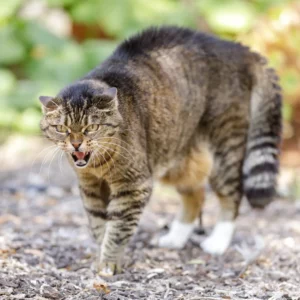Blog
Common Cat Behavior Problems: Understanding and Addressing
Cats are creatures of habit and mystery, often displaying behaviors that can be perplexing or even concerning to their human companions. Understanding the root causes of these behaviors and knowing how to effectively address them is crucial for a harmonious coexistence. This blog explores common cat behavior problems, their potential causes, effective solutions, and when it’s time to consult a veterinarian.
7 Most Common Cat Behavior Problems:
1. Inappropriate Urination
Causes: Stress, urinary tract infections, diabetes, kidney disease, or dislike of the litter box (cleanliness, type of litter, location).
Solutions: Ensure the litter box is clean, accessible, and in a quiet area. Experiment with different types of litter. Provide multiple boxes in multi-cat households.
When to See a Vet: If the behavior persists despite changes, or if you notice signs of discomfort while urinating, it’s crucial to rule out medical causes.
2. Aggression
Causes: Fear, pain, territorial disputes, or past trauma. Aggression can be directed towards humans, other pets, or objects.
Solutions: Identify and remove the stressor if possible. Use positive reinforcement and behavior modification techniques. Provide safe spaces for your cat to retreat.
When to See a Vet: Unexplained aggression, especially if sudden, warrants a veterinary examination to rule out pain or medical issues.
3. Excessive Vocalization
Causes: Breed characteristic (e.g., Siamese), attention-seeking, hunger, stress, or cognitive dysfunction in older cats.
Solutions: Ensure your cat’s physical needs are met. Establish a routine to reduce anxiety. Ignore attention-seeking meows to avoid reinforcing the behavior.
When to See a Vet: If there’s a sudden increase in vocalization or it’s accompanied by other signs of distress, a health issue could be the cause.
4. Scratching Furniture
Causes: Natural behavior to mark territory, stretch muscles, and maintain claw health. It may also indicate stress or lack of appropriate scratching surfaces.
Solutions: Provide a variety of scratching posts and pads. Place them near your cat’s favorite resting areas and the damaged furniture. Use catnip or toys to attract your cat to the posts.
When to See a Vet: If your cat seems to scratch excessively or aggressively, it might be experiencing anxiety or skin issues.
5. Over-grooming or Hair Pulling
Causes: Stress, allergies, skin conditions, or boredom can lead to excessive grooming or hair pulling.
Solutions: Increase environmental enrichment with toys, puzzles, and perches. Use feline pheromone diffusers to reduce anxiety. Regular grooming may also help.
When to See a Vet: Persistent overgrooming, especially if resulting in bald patches or skin lesions, requires veterinary attention to identify and treat the underlying cause.
6. Nighttime Activity
Causes: Cats are naturally crepuscular (most active at dawn and dusk). A lack of daytime activity or an inconsistent schedule can exacerbate nocturnal behavior.
Solutions: Provide ample playtime during the day. Establish a bedtime routine that includes a play session to expend energy.
When to See a Vet: If your cat’s nighttime activity is sudden or accompanied by other unusual behaviors, it could indicate a health problem.
7. Avoidance or Hiding
Causes: Fear, stress, illness, or a change in the environment can lead to avoidance or excessive hiding.
Solutions: Provide safe hiding spots and avoid forcing interaction. Gradually introduce new pets or changes in the household.
When to See a Vet: If avoidance behavior is sudden or your cat seems lethargic or uninterested in food, a vet visit is necessary to rule out medical issues.
Conclusion
Many common cat behavior problems stem from natural instincts, environmental factors, or health issues. Understanding the cause is the first step toward resolving the issue. In many cases, simple changes in the environment or routine can significantly improve common cat behavior. However, sudden changes or common cat behavior that is accompanied by signs of distress should prompt a visit to the veterinarian to ensure your cat’s health and well-being. By addressing common cat behavior problems with patience, empathy, and care, you can foster a loving and harmonious relationship with your feline friend.



